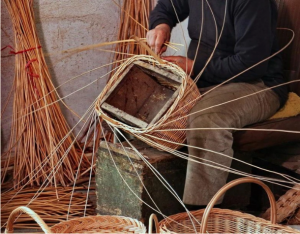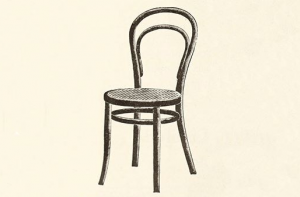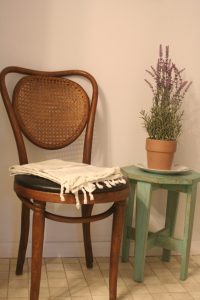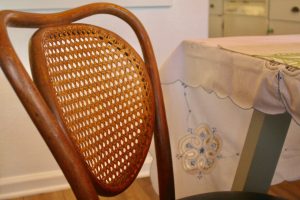Last Updated on October 3, 2023 by Rachel Granholm
With the stunning natural texture and smooth, clean lines, it’s no wonder cane furniture has been loved for centuries and is still loved and used in homes all over the world.
Lightweight and airy, it creates a casual, neutral space and it’s beautiful weave makes your home feel rejuvenated. Read on for the history behind cane chairs and some inspiration on how to style this furniture in your home!
What is Cane?
Cane is referred to the material that comes from the outer skin of a rattan stalk.
Rattan is a climbing-like vine plant that is in the palm family. It is native to Asia and Africa and is mainly found in Indonesia. Rattan grows in solid stalks in the jungle and can grow hundreds of feet in the air.

photo credit: kulture home decor
When the rattan is harvested, the thorns and any protruding pieces from the stalk are removed and the bark is separated from the core. The bark is then refined into thin strips, which are woven to create caned furniture.
These strips create beautiful and long lasting furniture because, since cane is the skin of the rattan plant, it is strong, flexible, and non-porous.

photo credit: kulture home decor
To help differentiate, the material is called cane, the process of creating the furniture is called caning, and the finished product is called caned furniture.
History of Cane
Cane strips have been used for centuries, used first as basket-making material and then progressing into furniture.
Cane was used all over Asia and Africa since ancient times, woven on pieces like Tibetan shields from the 14th through 16th centuries AD.
Caned furniture was introduced in Holland, England, and France during the 1660’s due to a vibrant trade with Asia. During this period, caning was mainly used for the seats and backs of wooden chairs.
According to mended-memories.com, caned chairs were wildly popular “because of their durability, lightness, and cleanliness from dust, worms, and moths, reminding us of how dirty interiors of that time period were.”
Because of the popularity, cane manufacturing in Europe exploded and remained as such through the 18th century.

photo credit: cane furniture renovations
Moving into the 19th century, caning became popular with Dutch and English colonial furniture, mainly because these countries had colonies in Indonesia where rattan was readily accessible and where the weaving technique had a long history.
The colonial style made it’s way across the globe to other European colonies and eventually into tropical climates, because, unlike solid wood furniture, the cane stood up to the high humidity and would not warp or crack.
Rise of the Cane Chair
In the mid-19th century, caning became the most highly regarded seat material thanks to a German cabinetmaker named Michael Thonet.
His No.14 chair from 1859 transformed the furniture industry. The simple nature of the chair and it’s caned seat gave the chair exceptional lightness, meaning it was less expensive to produce and easier to transport.
Caned chairs were loved because they were not only hygienic and breezy, but they were also not as heavy as solid wood pieces and less formal than the typical upholstered chairs of the era. Two twentieth century designers, Adolf Loos and Le Corbusier, admired the cane chair because it was a healthy and modern replacement to the heavier and bulky furniture of the time.

photo credit: the design museum
Cane Chairs Today
Blending old with new is the perfect way to think about using antique cane chairs in your home. Today, you can find cane chairs in antique stores, estate sales, and thrift stores for a good price. They come in a variety of styles that will blend seamlessly into any design style.
Cane Chair Styles
- stained, raw, or black wood
- caned back with wood seat
- wood back with caned seat
- caned back with upholstered seat
- caned seat with upholstered back
- chairs with or without arms
- caned seat and back with a wood base
- caned seat and back with a metal base

Creative Uses For Cane Chairs
The possibilities are endless as far as styles go, so let’s discuss how to use and style them in your home.
- mix and match caned chairs for your coffee nook or dining table
- a caned armchair or a pair of them would make a cozy reading area
- use one as a desk chair
- place a caned chair or a two in your entryway
- pair a caned chair with benches as dining table seating
- incorporate a caned chair into your bathroom
- utilize caned chairs in your kitchen at an island or as extra seating
- they look beautiful at the top of a stair landing

For A Simple Home
You can also try caning an old chair or repairing one yourself by purchasing cane from a retailer. Just go on Google and type in ‘where to buy cane’ and you will have many options to choose from. I pulled much of my inspiration for this post today from MaCenna over at XO, MaCenna on YouTube. She is such a gem and her content is out of this world. She has a whole video on DIY caning and many other home decor ideas. I will link her channel here. Go check her out as I guarantee you will find such encouragement from her.
The natural beauty of cane adds such warmth to your space. It’s texture combines vintage with modern, creating a charming simplicity. By incorporating caned chairs into your home you are creating a relaxed, collected-over-time feeling. I hope you found inspiration here today and are eager to seek out a caned chair or two for your home.

Let me know in the comments below how you would use a cane chair in your home!
If you are new here, I’m Rachel, the writer and content creator here at The Antiqued Journey. I’m so happy to have you! I encourage you to stop by the ‘about me’ page to get to know me a little more.
Here on the blog, you will find loads of inspiration for decorating with vintage and antique decor, simple DIY crafts and many thrifting adventures. If that interests you, I invite you to sign up for my e-mail. You will receive a free digital download as a thank you!






1 Comment. Leave new
[…] https://www.theantiquedjourney.com/cane-furniture-then-and-now/ […]